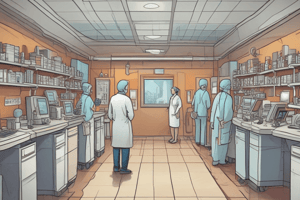Podcast
Questions and Answers
Which principle emphasizes the importance of learning from errors and near misses in a healthcare setting?
Which principle emphasizes the importance of learning from errors and near misses in a healthcare setting?
- Just Culture (correct)
- Active Failures
- Red Rules
- No Blame Culture
What is the primary benefit of a safety culture in a healthcare environment?
What is the primary benefit of a safety culture in a healthcare environment?
- It promotes an atmosphere of open communication about safety issues. (correct)
- It eliminates all medical errors completely.
- It enables quicker disciplinary measures for staff.
- It focuses solely on punishing those responsible for errors.
What does psychological safety entail in a healthcare organization?
What does psychological safety entail in a healthcare organization?
- Employees speak up without fear of retribution. (correct)
- Employees are guaranteed bonuses for reporting errors.
- Employees are immediately disciplined for mistakes.
- Employees are only recognized for their successes.
Which of the following is NOT a characteristic of Highly Reliable Organizations?
Which of the following is NOT a characteristic of Highly Reliable Organizations?
What is the consequence of not reporting mistakes in a Just Culture?
What is the consequence of not reporting mistakes in a Just Culture?
What are red rules designed to address in a workplace?
What are red rules designed to address in a workplace?
How does miscommunication impact patient safety?
How does miscommunication impact patient safety?
What barriers to disclosure might healthcare professionals face?
What barriers to disclosure might healthcare professionals face?
What is a key principle of Just Culture in healthcare settings?
What is a key principle of Just Culture in healthcare settings?
Which of the following best describes psychological safety in healthcare?
Which of the following best describes psychological safety in healthcare?
What characterizes highly reliable organizations in healthcare?
What characterizes highly reliable organizations in healthcare?
How does miscommunication in healthcare impact patient safety?
How does miscommunication in healthcare impact patient safety?
What is a common personnel barrier to disclosure of adverse events in healthcare?
What is a common personnel barrier to disclosure of adverse events in healthcare?
Which of the following is a system barrier to disclosure in healthcare?
Which of the following is a system barrier to disclosure in healthcare?
What is the purpose of forcing functions in healthcare?
What is the purpose of forcing functions in healthcare?
Which strategy is most effective in improving patient safety related to human factors?
Which strategy is most effective in improving patient safety related to human factors?
What is a key principle of Just Culture in healthcare?
What is a key principle of Just Culture in healthcare?
Which aspect is essential for fostering psychological safety in a healthcare environment?
Which aspect is essential for fostering psychological safety in a healthcare environment?
What characteristic is typical of highly reliable organizations in healthcare?
What characteristic is typical of highly reliable organizations in healthcare?
Which of the following is a common impact of miscommunication in healthcare settings?
Which of the following is a common impact of miscommunication in healthcare settings?
What is a significant barrier to disclosure of medical errors in healthcare?
What is a significant barrier to disclosure of medical errors in healthcare?
What is the focus of a culture of patient safety?
What is the focus of a culture of patient safety?
Which of the following describes a 'sentinel event' in healthcare?
Which of the following describes a 'sentinel event' in healthcare?
What is one of the main reasons errors occur in healthcare settings?
What is one of the main reasons errors occur in healthcare settings?
Flashcards are hidden until you start studying
Study Notes
Communication and Teamwork
- SBAR was developed to address communication and teamwork challenges in healthcare
- Other patient safety initiatives used to improve communication:
- Simulation training
- Rapid Response Teams (RRT)
- Walk-arounds
- Patient participation on committees and root cause analyses (RCAs)
Miscommunication
- Breakdowns in communication can lead to incorrect treatments, lack of treatment, or inaccurate self-care by the patient.
- Miscommunication can be caused by faulty systems (e.g., poor critical test result reporting), inadequate patient health literacy, or lack of cultural competency in the healthcare team.
Disclosure
- Implementing a transparent disclosure policy is crucial for patient safety.
- Includes a formal process for disclosing adverse events to patients and families.
- Provides support mechanisms for patients, families, and healthcare providers.
- Reasons for Disclosure:
- Builds Trust
- Supports Patient Safety Initiatives
- Required by The Joint Commission
Barriers to Disclosure
- Personnel Barriers:
- Fear of legal liability
- Fear of losing licensure
- Fear of punishment or job loss
- Feelings of vulnerability
- System Barriers:
- Difficulty accepting that even the most skilled professionals can make mistakes
- Conflicts of interest
Improving Patient Safety: Human Factors
- Human Factors focus on system design to prevent errors:
- Simplification: Streamlining processes
- Standardization: Creating consistent procedures
- Constraints and Forcing Functions: Preventing unintended actions
- Reduced Reliance On Memory: Implementing checklists and protocols
- Avoiding Fatigue: Ensuring adequate rest periods for staff
- Error Prevention: Emphasizing communication and training
Forcing Functions
- Designed to prevent a specific action or require a specific action before another can be performed.
- Example: Removing concentrated potassium from general hospital wards
Resilience
- Resilience refers to the ability to recover from or adjust to change. It's critical for individuals and organizations to adapt to challenges and bounce back from errors.
Swiss Cheese Model of System Error
- Illustrates how multiple layers of safeguards (like slices of Swiss cheese) can fail, allowing errors to occur.
- Each slice represents a system component with potential holes or weaknesses.
- Errors occur when these holes align, allowing a "path" for the error to reach the patient.
The Anatomy of Errors in Healthcare
- Two types of errors:
- Active Failures: Visible errors with immediate consequences, often directly caused by frontline staff (e.g., a nurse administering the wrong medication).
- Latent Failures: Hidden errors that may not be apparent for years, often due to system design flaws or organizational issues (e.g., inadequate training or unclear protocols).
Safety Culture
- A culture where everyone feels comfortable discussing safety concerns without fear of punishment.
- This promotes open communication and encourages reporting errors and near misses.
- Characteristics of a Safety Culture:
- Senior management prioritizes patient safety
- Supervisors acknowledge and reward safe practices
- Focus is on systemic issues rather than individual blame
Just Culture
- Three Key Principles:
- Accountability: Individuals are still responsible for their actions.
- Learning: Emphasis on learning from errors to prevent future occurrences.
- Safety: Encourages reporting of errors and concerns without fear of punishment. Creating a safe environment for reporting errors and concerns benefits both providers and patients.
Psychological Safety
- Encourages open communication and error reporting by creating a culture where individuals feel comfortable speaking up without fear of punishment or humiliation.
- No Blame Culture: Fosters a non-punitive environment that promotes voluntary reporting of adverse events.
Red Rules
- Unbreakable rules designed to prevent serious harm.
- Characteristics:
- Few in number
- Easy to remember
- Related to critical processes that pose severe risks
- Applicable to everyone, regardless of experience or rank
Highly Reliable Organizations (HROs)
- Characteristics:
- Risk Monitoring: Continuous monitoring for expected and unexpected risks.
- Reward Systems: Incentives for safe practices.
- Quality Standards: Specific system quality standards.
- Learning from Error: Acknowledging risk and learning from mistakes through root cause analyses (RCAs).
- Proactive Strategies: Implementing strategies to prevent sentinel events, using techniques like Failure Mode Effect Analysis (FMEA).
Patient Safety: Challenges and Concerns
- Challenges:
- Difficulty recognizing errors
- Lack of systems for tracking and identifying errors
- Eroded trust between patients and providers
- Shortage of healthcare professionals
- Concerns about liability
- Limited capacity and training in quality improvement tools (e.g., PDSA)
- Insufficient safety culture
Key Issues for Healthcare Organizations
- Establishing a culture of patient safety and just culture.
- Identifying and supporting patient safety champions within the organization.
- Implementing effective patient safety strategies.
- Adopting safety-related technologies.
Patient Safety Plan
- Key Components:
- Standardizing definitions and categorizing medical errors.
- Creating or enhancing error and near miss reporting mechanisms.
- Developing comprehensive data collection plans, reporting structures, and scheduling.
Patient Safety Terms
- Adverse Event (ADE): Injury or illness resulting from medical treatment.
- Medical Error: A mistake or deficiency in the process of healthcare delivery.
- Sentinel Event: Serious, unexpected event resulting in death or serious permanent injury (e.g., wrong-site surgery).
- Near Miss: A potential error that could have resulted in a serious event but did not.
Key Points to Remember:
- The blame-free environment is crucial to promoting a culture of safety and transparency.
- It is not about who caused the error but what caused it.
- By focusing on system improvements and learning from mistakes, healthcare can create a safer environment for patients.
Studying That Suits You
Use AI to generate personalized quizzes and flashcards to suit your learning preferences.





